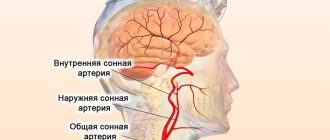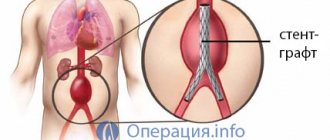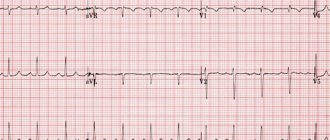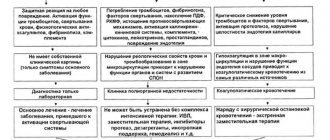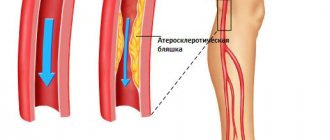A pathological protrusion of the wall of the femoral artery is called an aneurysm. It occurs when the medial lining of the vessel becomes thinner. Initially, it is asymptomatic, but as it develops it becomes complicated by blockage of the artery lumen with a thrombus or rupture with massive bleeding. Treatment requires surgery - removal of the aneurysmal sac or installation of a shunt or stent.
Causes of the disease
It is not always possible to determine the etiology of aneurysm formation. Based on scientific research, this disease is recognized as multifactorial. The main causes of changes in the arterial wall are:
- genetic predisposition;
- atherosclerotic changes in blood vessels;
- congenital connective tissue defects (Marfan syndrome, Ehlers-Danlos syndrome, fibromuscular dysplasia, elastin deficiency);
- inflammation of the artery (arteritis);
- periarteritis nodosa;
- blockage by embolus due to a bacterial or fungal infection;
- malignant or benign neoplasms;
- radiation therapy;
- gunshot wounds, stab wounds, blows with blunt objects;
- operations and diagnostic studies.
Risk factors include the presence of certain pathologies in the patient: arterial hypertension, polycystic kidney disease, obesity, nicotine or alcohol, drug addiction.
We recommend reading about aortic aneurysm surgery. You will learn about the indications for surgery, what surgical interventions are performed, as well as rehabilitation and consequences after them. And here is more information about atherosclerosis of the abdominal aorta and iliac arteries.
Prevention
Patients with a tendency to pathologies of the femoral artery should adhere to certain rules of life. It is important to control blood sugar and lipid levels.
Lipid profile
Their increased concentration is the main cause of diseases of all blood vessels, not just the femoral artery. If you have diabetes, you must regularly undergo treatment with antiglycemic drugs.
Timely prevention and treatment of related diseases is of great importance:
- provoking changes in the rheological properties of blood;
- leading to weakening and fragility of vascular walls;
- causing deformation of the venous membranes;
- generating inflammation of blood vessels.
The femoral artery is under strong mechanical pressure with excess body weight and increased blood pressure. Therefore, you need to monitor weight gain, adhere to a healthy lifestyle and a balanced diet.
Elderly people are advised to follow an anti-sclerosis diet. It is important to minimize stressful situations, spend more time in the fresh air, and use moderate physical activity.
Symptoms of a femoral artery aneurysm
Patients usually do not feel the initial manifestations of the disease. But aneurysms tend to gradually increase in size under the influence of blood pressure. A large formation disrupts blood flow and the passage of nerve impulses. The following symptoms occur:
- pain in the groin or thigh area, increasing with physical exertion;
- sensation of pulsation;
- numbness of underlying tissues;
- convulsive muscle twitching;
- pallor and cyanotic tint of the feet.
At the site of the aneurysm, a swelling of the skin appears, which has a dense consistency, round or oval shape, and pulsates in time with the contractions of the heart. In the formed sac, blood flows not in a straight line, but along the walls, the direction changes from linear to turbulent. This leads to accelerated thrombus formation and cessation of tissue nutrition.
What does "false aneurysm" mean?
If the femoral artery is damaged from the outside during puncture, vascular surgery, a gunshot wound, or a blow with a piercing or blunt object, then a disease such as a false aneurysm occurs. The place where the integrity of the vessel is damaged is covered with skin or soft tissue, and the leaked blood remains in the soft tissues.
A pulsating hematoma is formed, which is not in the direct sense an aneurysm . Blood clots appear in the cavity of this formation, they gradually become denser and become covered with a capsule, which fuses with the wall of the artery and looks like an aneurysmal protrusion.
Place of pulsation
Examination of the femoral artery is performed with the patient in a horizontal position. He should extend his legs and slightly externally rotate his hips. By placing your right hand on the area of the femoral triangle and slightly immersing it in the tissue, you can feel the place of greatest pulsation. Weak pulsation is allowed in healthy people with poorly developed muscles and poor nutrition. It intensifies with physical activity. Also, with normal hemodynamics, the color and trophism of the skin, nails and muscles, the motor function of the limbs are the same on both sides and do not differ from other parts of the body. Violations manifest themselves in the form of:
- changes in skin color: pallor, marbling;
- trophic disorders: hair loss, ulcers, muscle and skin atrophy;
- motor dysfunction.
Processes can be one- or two-way.
If a superficial examination is not enough, the femoral artery is palpated. This is convenient, since the vessel is quite large and is located close to the skin. The doctor determines the temperature of the skin, its turgor, muscle tone and strength and makes a comparison between the limbs.
Too weak pulsation of the femoral artery is a sign of vascular obstruction, thrombosis, atheromatosis. Increased pulsation is observed with arterial hypertension, thyrotoxicosis, and aortic insufficiency. Additional noise other than systolic tone is unacceptable.
How dangerous is a gap?
Many patients, unaware of the presence of an aneurysm, continue to lead a normal lifestyle. The formation and growth of this formation can last more than 3 years, accompanied by minor symptoms. Under the influence of physical overload, during pregnancy or childbirth, with a sharp increase in pressure, a rupture of the wall of the femoral artery can occur. If the patient is not operated on in a timely manner, intense bleeding is life-threatening.
In addition to rupture, the presence of an aneurysm increases the risk of the following complications:
- blockage of an artery by a blood clot;
- movement of parts of a blood clot with embolism of the branches and gangrene of the lower extremities;
- suppuration of a hematoma (false aneurysm) with phlegmon of surrounding tissues;
- trophic disorders (dermatitis, ulcers) due to lack of blood flow.
Deep femoral artery
It starts at the back of the joint, slightly below the groin. This branch is the largest. The vessel stretches through the muscle tissue, first goes outward, then goes down behind the femoral artery. The branch then moves between the muscles of the area in question. The trunk ends approximately in the lower third of the thigh and is directed into the perforating arterial canal.
The vessel that goes around the femur leaves the deep trunk, heading into the depths of the limb. After this it passes near the neck of the femur.
Diagnostic methods
External signs of the disease are the presence of a dense pulsating formation. During auscultation, a systolic murmur can be heard above it, which disappears when the overlying area is compressed. Below the location of the aneurysm, decreased pulsation of the arteries is noted. To confirm the diagnosis, angiography and ultrasound of the vessels of the lower extremities with duplex scanning are indicated. These techniques help establish:
- true dimensions;
- form of education;
- the state of blood circulation above and below the aneurysm;
- availability of workarounds.
Such data is important for planning surgical intervention.
Diagnosis and treatment of the disease
This disease should not be left to chance; at the first symptoms, it is better to see a doctor. Then you will have to do a series of instrumental studies, including duplex ultrasound scanning and arteriography. These methods allow you to see the location of the arterial aneurysm and determine its size.
In case of an asymptomatic course of the disease and with a slight increase in the lumen of the vessel, a wait-and-see approach is recommended, which consists of periodic monitoring of the condition of the artery using ultrasound scanning. With the possible development of complications, in particular thrombosis or rupture of an aneurysm, treatment is exclusively surgical.
The basic treatment method is surgery, which prevents potentially dangerous complications, in particular blockage of blood circulation in the lower limb and the formation of blood clots. In medicine, there are several methods of surgical intervention:
- Open surgery involves cutting through the soft tissue to gain direct access to the blocked artery. After which the aneurysm is bypassed, i.e. a vessel from another part of the body or an artificial implant is taken and sewn in, bypassing the aneurysm.
- Endovascular (closed) surgery is a minimally invasive procedure with a minimum of traumatic manipulations. A catheter is inserted through a small incision in the skin, then a cylindrical stent made of wire is installed. It serves to strengthen the walls of the vessel, preventing their stenosis (fusion), the formation of blood clots and rupture of the aneurysm. After such an operation, the patient recovers quickly and does not stay in the hospital for long.
Treatment of femoral artery aneurysm
Conservative treatment in the presence of an aneurysm is not carried out. With the help of medications, you can only delay the rupture of the artery wall by using antihypertensive drugs. The optimal treatment option is surgery. The main types of surgical interventions are presented in the table.
| Types of surgery | Short description |
| Prosthetics | A section of the vessel with the aneurysmal sac is excised, and in its place a prosthesis made of synthetic material or the patient’s vein is installed. |
| Bypass surgery | After removing the fragment of the artery with the aneurysm, a bypass path is created to feed the tissue; the patient’s own vessel (usually a peripheral vein) is used for the shunt. |
| Stenting | It is considered a less traumatic technique, since it does not require open access; a metal frame is inserted into the vessel, which strengthens the walls of the femoral artery, preventing its rupture and thrombosis. |
If the size of the operation is small and the risk is high, a wait-and-see approach may be chosen. In this case, physical overexertion is contraindicated for the patient; medications are prescribed to maintain normal blood pressure and prevent blood clots. Such patients should be regularly examined and observed by a vascular surgeon.
We recommend reading about femoral artery occlusion. You will learn about the causes of femoral artery occlusion, the process of occurrence, types of occlusion and symptoms by stage, as well as methods of diagnosis and treatment. And here is more information about carotid artery aneurysm.
Aneurysm of the femoral artery occurs when the membranes of the vessel are thinned (true) or external damage (false). Initial manifestations are usually absent. As it grows, the blood supply and innervation of the tissues of the lower extremities is disrupted, which is manifested by pain, convulsions, numbness and the formation of a pulsating swelling on the skin.
To confirm the diagnosis, angiography and vascular ultrasound are indicated. Treatment of an aneurysm is surgical - excision of an expanded fragment, prosthetics, bypass surgery or stenting.
Treatment with folk remedies
It will not be possible to completely recover from a femoral artery aneurysm using the traditional method, but you can alleviate the disease by strengthening blood vessels and improving blood circulation.
It is best to make decoctions based on Siberian elderberry and dill; this does not require complex steps. The first recipe is prepared from 1 tablespoon of chopped elderberry root, poured with a glass of boiled water, and the mixture is placed on the stove for 15 minutes over low heat. Leave in a cool place for half an hour, use 2 tbsp of the prepared broth. daily.
For dill infusion, take a 300 ml spoon of the plant. boiling water, after cooling, the intake is equal to one tablespoon before meals.
Self-medication is carried out before consulting a doctor, otherwise unpleasant consequences are guaranteed.
To reduce the risk of developing an aneurysm, you should carefully monitor your own health, it is advisable to say goodbye to bad habits and start following a diet. If it was not possible to prevent the rupture of the artery, then it is necessary to contact a surgeon without bringing the situation to a sad outcome.
